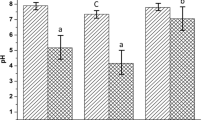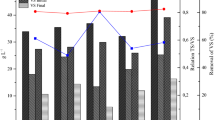Summary
Generation rate of biogas and its methane component, as well as changes of major organic fractions during anaerobic digestion of fresh cow dung alone and in combination with each of air-dry rice straw, maize stalks, and cotton stalks at a ratio of 1∶1 (on the basis of 70°C dry weight of either source) have been monitored in laboratory fermenters for 75 days at 35°C. Mixtures of cow dung + maize stalks produced the highest cumulative volumes of both biogas and its methane component; i.e. 17.9 and 8.31/1 fermented material respectively, cow dung alone surpassed all of the tested biomass regarding the yield of methane production in relation to the volatile solids consumed which gave 636 l/kg; the other materials came in the succession: cow dung + maize stalks, cow dung + rice straw and cow dung + cotton stalks. Acetic, propionic, and butyric were the major detectable fatty acids formed during the digestion course. Cow dung excelled the other treatments in amounts of such acids produced. Combination between cow dung and crop residues resulted in reducing the formation of fatty acids and NH +4 and loss of nitrogen, but enhanced the disappearance of volatile solids, fats, hemicellulose and cellulose. The lignin content remained unchanged.
Résumé
La vitesse de genèse du biogaz et son contenu en méthane, ainsi que les modifications des principales fractions organiques pendant la digestion anaérobie a été examinée en fermenteurs de laboratoire pendant 75 jours à 35°C pour les bouses bovines fraîches, seules et en mélange 1∶1 (sur la base du poids sec à 70°C) soit avec la paille de riz séchée au soleil, les fânes de maïs ou les tiges de cotonniers. Le mélange de bouses de vache et de fânes de maïs a produit le volume cumulatif le plus élevé tant de biogaz que de son constituant, le méthane, notamment respectivement 17.9 et 8.31/l de matériel fermenté. Les bouses de vache ont surpassé toutes les biomasses testées quant au rendement de la production de méthane par rapport aux solides volatils consommés qui donna 6361/kg; les autres matières viennent dans l'ordre décroissant: bouses de vache plus fânes de maïs, bouses de vache plus paille de riz et bouses de vaches plus tiges de cotonniers. Les acides gras principaux détectés et formés pendant le cours de la digestion étaient l'acide acétique, l'acide propionique et l'acide butyrique. La biométhanisation de bouses de vache a excellé par rapport à celle d'autres substrats quant aux quantités produites de ces acides. Le mélange de bouses de vache et de résidus agricoles a résulté dans la diminution de la formation d'acides gras et d'ammonium et de la perte en azote mais dans l'augmentation de la disparition des solides volatils, des graisses, de l'hémicellulose et de la cellulose. Le contenu en lignine est resté inchangé.
Similar content being viewed by others
References
APHA (American Public Health Association) 1976Standard Methods for the Examination of Water and Waste Water. 14th edn, Washington, D.C.
Bryant, M.P. 1974 Nutritional features and ecology of predominant anaerobic bacteria of the intestinal tract.American Journal of Clinical Nutrition 27, 1313–1322.
Chapman, M.D. &Pratt, P.F. 1961 Methods of Analysis for Soils, Plants and Water. University of California, Division of Agricultural Sciences.
Chengdu, S. 1979 Biogas Technology and Utilization. Sichuah Provincial Office of Biogas Development, China.
Ghosh, T.S. andKlass, D.L. 1978 Two-phase anaerobic digestion process.Biochemistry 13, 15–24.
Han, Y.W. &Anderson, A.W. 1975 Semi-solid fermentation of ryegrass straw.Applied Microbiology 30(6), 930–934.
Han, Y.W. 1982 Cellulose Bioconversion.The Third Regional Training Course of The Egyptian Society of Applied Microbiology on Prospectives of Technologies and Techniques of Applied Microbiology and Waste Recycling, Cairo, Egypt.
Hill, D.J. 1979 Effect of carbon:nitrogen ratio on anaerobic digestion of dairy manure.Agricultural Wastes 1(4): 267–272.
Hobson, P.N., Bousfield, S. &Summers, R. 1974 Anaerobic digestion of organic matter,Critical Review in Environmental Control 4, 131–191.
Hobson, P.N., Robertson, A.M. andMills, P.J. 1975 Anaerobic digestion of agricultural wastes.Research Review 1(3), 82–96.
Hobson, P.N., Bousfield, S. andSummers, R. 1981Methane Production from Agricultural and Domestic Wastes. London: Elsevier Applied Science Publishers, Ltd.
Kononova, M.M. 1966Soil Organic Matter: its role in soil Formation, and in Soil Fertility. New York and London: Pergamon.
Kroeker, E.J., Schulate, D.D., Sparling, A.B. andLapp, H.M. 1979 Anaerobic treatment process stability.Journal of Water Pollution Control Federation 51(4), 518–529.
Maramba, F.D.Sr 1978 Biogas and Waste Recycling; the Philippines experience. Maya Farms Division, Liberty Flour Mills, Inc. Metro Manilla, Philippines.
MaCarty, P.L. &McInerney, R.E. 1961 Salt toxicity in anaerobic digestion.Journal of Water Pollution Control Federation 33, 399–415.
McInerney, R.E. &Bryant, M.P. 1981 Review of methane fermentation fundamentals. InFuel Gas Production from Biomass ed. Wise, D.L. Florida: CRC Press.
National Academy of Sciences 1981Methane Generation from Human, Animal, and Agricultural Wastes. Washington, D.C.
Neish, A.C. 1952 Analytical Methods for Bacterial Fermentation. Report No. 46. National Research Council of Canada.
Park, Y.D. 1979 Factors affecting net energy production from mesophilic anaerobic digestion. InThe first International Symposium on Anaerobic Digestion, Cardiff, UK.
Sathianathan, M.A. 1975Biogas Achievements and Challenges. New Delhi, India: Association of Voluntary Agencies for Rural Development.
Van Velsen, A.F.M. &Lettinge, D. 1979 Effect of feed composition of digester performance. InThe First International Symposium on Anaerobic Digestion. Cardiff, UK.
Waksman, S.A. 1952Soil Microbiology. New York: John Wiley.
Wujick, W.J. &Jewell, W.J. 1980 Dry fermentation.Biotechnology and Bioengineering Symposium No. 10.Gatlinburg, Tennessee, USA.
Author information
Authors and Affiliations
Rights and permissions
About this article
Cite this article
El-Shinnawi, M.M., El-Tahawy, B.S., El-Shimi, S.A. et al. Fractionation of organic substances during anaerobic digestion of farm wastes for biogas generation. World J Microbiol Biotechnol 5, 27–42 (1989). https://doi.org/10.1007/BF01724956
Received:
Accepted:
Issue Date:
DOI: https://doi.org/10.1007/BF01724956




